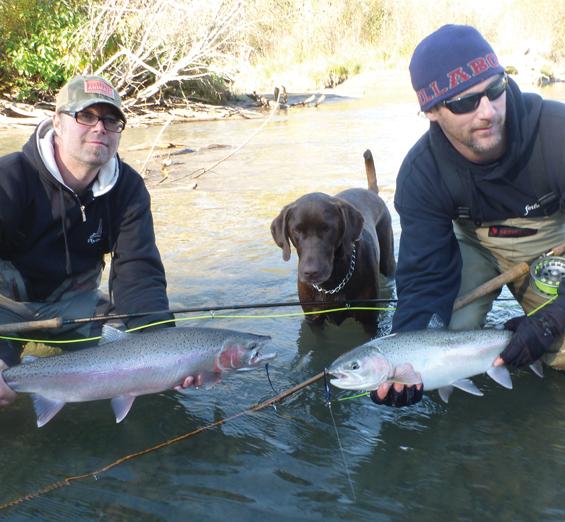With fall over it’s time for the silver ghosts make their way home. These sensuous fish are each different, like a fingerprint, from the spots on their backside to the rosy hue on the cheek of a hell buck. It’s easy to love everything about them from the hunt, to the approach and trying not to spook them, to the fight and the subsequent release of a pure and wild fish.
Advertisement

Targeting and Tactics
There are so many ways to target winter-runs, some more efficient, some more pleasurable. I enjoy swinging a fly. When proper tension is applied you feel everything from the light pluck of a steelhead to the tick of a rock . Nymphing, however, is more efficient and leads to more fish. On occasion I will nymph or float-fish with pre-war gear and fibreglass rods. I love being able to feel every surge that bends right through the cork. There’s the notion that these ghosts are hard to catch. They’re just less numerous thus more elusive. The successful steelheader is a hunter, always on the move, covering many miles in search of these glorious slabs of chrome.
Fly fishers need to resort to different tactics, since winter-run fish aren’t as active as the summer- to fall-runs. I believe steelhead are best taken at first and last light. That isn’t to say they can’t be taken mid-afternoon, it’s all about the timing.
Flies and Swings
Every fish will hold in different water, it’s a matter of where they feel safe. In deep water, you need to get down to them using a sink tip in various lengths and sink rates. Store bought or bulk sink-tip line is made in different grades of tungsten, the higher the number the faster the sink rate.
Advertisement
The swing is the thing. Cast above your desired area and mend your line upstream according to the water current, sometimes putting a couple extra in to allow your fly to get down. After you cast your line, pick your rod up and in one movement lift it up and over, upstream. This will remove the belly in the line, slow it down and allow it to sink more quickly to the depths where the ghosts live. Then you are swinging right away and should feel the pull of your line through the rod while it searches through the current. This is a very pleasing way to search for steelhead. When a proper fly is tied on to a short leader of fluorocarbon, three to four feet is all you need.
Choose your fly from Popsicle leeches to Intruder flies. Intruders catch fish all year, regardless of the system; I just adjust the length and color depending on where I am. The trick to the lightweight balanced fly that swims but doesn’t plummet down is to use a faster sink tip in accordance with the water.
Advertisement
When the hunting becomes a numbers game, I often get fish with nymph fishing. Like float fishing, when nymphing you systematically dissect a piece of water more effectively than when swinging a fly. To nymph a fly, use a floating line, a long leader and something as simple as a weighted bug to get down to the fish. The best piece of advice may be this: purchase high-end line with a taper that will aid in casting heavy flies in big wind.
Indicators
Strike indicators aid in strike detection and help achieve the required depth. Steelhead often take your presentation and spit it out before you even know it happened. Some, instead of an indicator, use the floating line as a float. Remember: keep in touch with your fly, know where it is, know what the happy tension is and keep it in the zone.
Nymphing
To properly nymph, use an upstream cast, keep loose line off the water and ride the current seam by holding the rod high.
Follow the line with your rod and mend up or downstream, according to the current, to keep a drag-free drift. Gently lower the rod tip at the end to extend the drift; now you can place your fly above, beside or behind rocks, logs or any prime steelhead sanctuary.
Weight
Weight is necessary. As a fly-tier, use .10 to .30 lead wraps in your flies. Beadheads, coneheads and eyes can all help in bringing the fly down to the fish. Split shot, twist-on lead or deep soft weight installed on your leader can help; add a two-way swivel so they don’t slide down; add two feet of leader and you’re float fishing.
Single eggs are effective tied with Globug yarn, chenille wool, glue gun eggs or trout beads in all the colours of the rainbow. Patterns such as the Squamish poacher, made to represent a shrimp, are awesome for taking steelhead as are stonefly nymphs, made to tumble along the bottom. Whichever method you choose, just remember, we’re all out there fishing for the same thing.